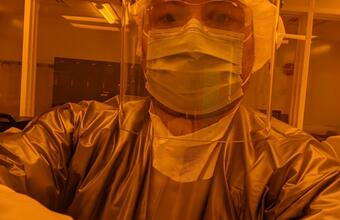
Nathanael Eddy started his graduate studies at Queen’s University in 2019. He has a daughter Alicia (6), a son Matthias (2) and daughter Abbie (6 months). He completed a Master’s of Mathematics for Teachers (MMT) degree at the University of Waterloo and received his teaching (BEd) and science (BSc Honours Physics) degrees from Brock University. After teaching high school math and science for 6 years, he resigned his position to pursue his love of research. Having previously resided in Kingston, Queen’s University was a natural choice. He is currently taking parental leave to spend more time with his family. Nathanael explains, “with full time studies and young children, there’s not a lot of time to catch your breath.” He stresses however, that he wouldn’t be where he is today in his education without the support of his wife. Being an active presence in his children’s lives is extremely important to him, so he makes sure to spend time with them on the weekends and help them with their homework even after 8-9 hours in the lab. He says his supervisor (Dr Robert Knobel) has been very supportive of his parental roles too. The Physics Department has been very accommodating, and he is very thankful for this understanding from Queen’s.
Nathanael says that work-life balance is harder with more than one kid, especially when Abby is a daddy’s girl and his toddler is at a very busy age. Being a father has made him starkly aware of the value of time; he is much more flexible, deliberate and mindful of his time, as his top priority is his time with the kids. He says being a graduate student father is like having two full-time jobs and he isn’t able to join in on all the socials (even though he’d like to) because “life isn’t just about me and my research anymore” and that he has to schedule his time “thinking of the family first,” making sure he is available when needed.
Nathanael is very passionate and serious about his research. He works with 2-dimensional (2D) materials, such as graphene and niobium diselenide, which form in sheets of atomic thickness. At such extremes these materials can have interesting properties. Ultimately, his research intends to better understand the physical properties of 2D materials in order to contribute to the development of essential new devices across many industries.
How does Nathanael accomplish this through his research? Nathanael creates samples which can be viewed (with the proper substrate) under a microscope. The crystals are then picked up and carefully placed into circuits. Nathan's work involves a few extra steps where he suspends the crystals above electrodes so they can vibrate when exposed to an electric signal. Nathan is then able to perform experiments to determine properties of the suspended drumhead, as well as measure the motion of the drumhead. This research has foundational applications in force sensors, gas sensors and quantum computing, all in high demand now.
For more details on the PhD program in Physics, check out the Physics, Engineering Physics and Astronomy website.